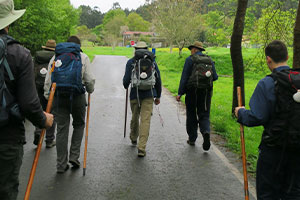
In a world full of agitation, instant gratification and constant novelty, a growing number of Americans are seeking something more.
Many people are finding that “something more” in Catholic pilgrimages. They are on the rise, and they are here to stay.
After doing the “Camino” (or pilgrimage route) to the tomb of Saint James the Greater in Spain last spring, my interest in pilgrimages was sparked. I recently noticed several news sources reporting on a plethora of “Caminos.” These pilgrimage routes are emerging from the ruins of our modern atheistic world. Surprisingly, they are not found on the other side of the world but right in our backyard here in America. I will cite a few examples.
One pilgrimage celebrates the life of Father Emil Kapaun, the Korean War chaplain who gave his life for his Church and country. Fr. Kapaun’s body was finally discovered and returned to Kansas in 2021. The holy priest now has a process of canonization.
The pilgrimage is known as the Kansas Camino. It started about 15 years ago with only five people. The 60-mile route starts in Wichita and ends at the priestly war veteran’s home parish in Pilsen, Kansas. This year, the pilgrimage had 300-plus participants.
Another pilgrimage is the Joseph Challenge Pilgrimage in my hometown of St. Louis, Missouri. This is a shorter 24-mile pilgrimage route for men. The pilgrimage marches toward the historic St. Joseph’s Shrine. The parish church began in 1843. It was a Jesuit church that, many years later, was turned over to the St. Louis Archdiocese. The church, known for its splendorous main altar dedicated to Saint Joseph, was constructed as a fulfillment of a promise made by the pastor and several families in the parish to be saved from the ravages of a cholera epidemic. The pilgrimage has been around for nine years and has typically around 30 participants.
Help Remove Jesus Bath Mat on Amazon
The Maryland Camino used to be a one-day event. The interest in the event was so great that it has just been expanded this year to an impressive 14 days of walking. Starting on Point Lookout in Scotland, Mayland, it ends with a Mass at the Saint Elizabeth Ann Seton Shrine in Emmitsburg. The pilgrimage covers 218 miles and includes visits to multiple historic churches associated with Maryland’s rich Catholic history.
The Katy Trail Marian Pilgrimage is another one of note. The pilgrims travel on the famous Katy Trail which spans almost the width of the state of Missouri. The program normally consists of five days and involves some 50 miles of walking while visiting seven Catholic churches along the way.
One of the early American pilgrimages is the Pilgrimage for Restoration in New York State. Now entering its 29th year, the pilgrimage starts at the town of Lake George on the lake with the same name. The pilgrimage is held in late September and lasts three days. It entails roughly 20 miles of walking per day.
The destination is the famous North American Martyrs Shrine in Auriesville, New York. The shrine is where great missionary saints gave their lives in the mid-seventeenth century. These martyrs include Sts. Rene Goupil, Isaac Jogues and John LaLande. Groups of 35-40 walk together with a chaplain. The pilgrimage closes with a traditional Mass at the church on the shrine’s premises.
Satanic Christ Porn-blasphemy at Walmart — Sign Petition
The most impressive example of the new American pilgrimage phenomenon is the National Eucharistic Pilgrimages being held across the United States this year from four different routes. The pilgrimages will take the Blessed Sacrament across the nation for a total of 6,500 miles, walked collectively by many groups of youth and other Catholics. The four routes will converge in Indianapolis for the National Eucharistic Congress to be held on July 17-21, 2024. The last congress of its kind was in St. Paul, Minnesota, 83 years ago.
These examples of pilgrimages testify to a thirst within the souls of many Americans for something this world is clearly not providing. What is that something?
A recent news item about these pilgrimages provided some answers about why they would engage in something usually buried in medieval storybooks.
One pilgrim testified that he wanted to unite his suffering with that of Our Lord, and a pilgrimage was a magnificent way to do so. While a pilgrimage is not easy, it allows time for reflection and old-fashioned penance. Another comment explained the satisfaction of giving public witness to the faith.
How Panera’s Socialist Bread Ruined Company
Another compares a pilgrimage to our life’s journey, which ends in our eternal reward in Heaven. Still others saw how the pilgrimage gives a purpose to life in contrast to the modern world and its empty pleasures.
Indeed, a pilgrimage is a kind of Way of the Cross, where each person seeks the path to Calvary. Finishing the route provides a sense of fulfillment. May Our Lady of Refuge, the Divine Pilgrim, Patroness of the Pilgrimage to Santiago, keep and bless the efforts of her pilgrims all the days of their lives.
“Grant me, Jesus, the grace to continue to embrace my cross, even when I collapse under its weight. Grant me the grace to rise up again whenever I grow faint. Grant me, Lord, the supreme grace of never departing from the way by which I must reach the height of my own Calvary.” (Third Stations, Way of the Cross, Plinio Corrêa de Oliveira)


